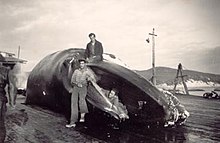Cheyne Beach Whaling Station
| Cheyne Beach Whaling Station | |
|---|---|
 The station in 2013 | |
 | |
| General information | |
| Type | Historic Whaling Station |
| Location | Albany, Western Australia |
| Coordinates | 35°05′41″S 117°57′35″E / 35.09472°S 117.95972°E |
| Type | State Registered Place |
| Designated | 15 May 1998 |
| Reference no. | 3644 |




Cheyne Beach Whaling Station is a defunct
The station takes its name from Cheynes Beach, a small coastal community located approximately 65 kilometres (40 mi) east of Albany, Western Australia and surrounded by Waychinicup National Park.[2]
History
Whalers had been recorded at Cheynes Beach in the 1840s with a commercial fishing operation being established there in 1920.[2] Whaling recommenced there in the early 1950s and the Cheynes Beach Whaling Company was formed by a family syndicate of eight fishermen. The syndicate was headed by two Albany men, G. R. Birss and C. Westerberg, who expected to outlay £20,000 on the venture.[3] The business was relocated to the Frenchman Bay site shortly afterward.[2]
Quotas were set for
The station produced a total of 500 long tons (508 t) of whale oil during the 1953 season. The oil was loaded aboard the Norwegian boat Toulouse ferried by the chaser Cheynes from the station to the boat.[8]
In 1954 the station loaded over 1,000 long tons (1,016 t) of whale oil, product of 120 whales or the entire season, directly onto the Norwegian ship Tiber using the station chaser Cheynes again. The oil had an estimated worth of £100,000.[9]
The company slowly continued to grow and in 1957 purchased a second chaser Kos VII.[6]
Following a disastrous season in 1962 with record low catches the International Whaling Commission ended whaling of humpbacks from Antarctic stocks so the company commenced hunting sperm whales instead. The enterprise remained profitable with the company recording a net profit of A$100,362 in 1969 that grew to A$304,329 in 1970. The higher profits were due to a record catch of sperm whales at the station, 764 in total, and unprecedented world demand for oil.[10] The company employed over 100 staff, and the oil was being used by NASA and to make Swiss watches.[11] Whaling continued from the station until 1978 when the last whale was legally caught in Australian waters.[4][12]
A total of 1136 humpbacks and 14,695 sperm whales were caught from the station between 1952 and 1978.[11]
The Cheynes Beach Whaling Company closed in 1978 and the site was given to Jaycees Community Foundation in 1980. The Foundation converted the station to a museum named Whaleworld using government and private funding.[5] Whaleworld was officially opened in May 1985.[13] The current name of the museum is Albany's Historic Whaling Station.[1]
See also
Australian Wildlife Park Albany
The Australian Wildlife Park Albany located adjacent to the Cheyne Beach Whaling Station Museum is a 1.3-hectare (3.2-acre) wildlife park which offer close up experiences with native animals such as: Southern Hairy-nosed wombat, Koalas, Brushtail possums (including rare golden-coated individuals), Quenda bandicoots, Spotted-tailed quoll, Red kangaroos, Western grey kangaroos (including rare albino individuals), Euro wallaroos, Tammar wallabies, Bennet wallabies, Tasmanian pademelons, Long-nose potoroos, Rufus bettongs, Brush-tail bettongs (Woylie), Stimson's python, Lizards, Tawny frog mouth, Brush tone curlew, Owls, Rufus night heron and Major Mitchell cockatoos.[14]
References
- ^ a b "Historic Whaling Station". Discovery Bay. Retrieved 8 August 2015.
- ^ a b c "Cheynes Beach". albanygateway.com.au. Retrieved 8 August 2015.
- ^ "Cheyne Beach Whaling Station". Great Southern Herald. Katanning, Western Australia. 12 May 1950. p. 1. Retrieved 23 August 2015 – via National Library of Australia.
- ^ a b "Australian whaling history preserved in the Archives". National Archives of Australia. 11 July 2013. Archived from the original on 19 September 2015. Retrieved 8 August 2015.
- ^ a b c "Cheyne Beach Whaling Station". inHerit. Heritage Council of Western Australia. 8 February 2015. Archived from the original on 4 March 2016. Retrieved 9 August 2015.
- ^ ISBN 0170051676.
- ^ "Whaling firm aims to start in May". The West Australian. Perth. 19 February 1952. p. 6. Retrieved 23 August 2015 – via National Library of Australia.
- ^ "Whale Oil Line Repaired". The West Australian. Perth. 28 September 1953. p. 14. Retrieved 23 August 2015 – via National Library of Australia.
- Daily Commercial News and Shipping List. Sydney. 6 October 1954. p. 1. Retrieved 23 August 2015 – via National Library of Australia.
- ^ "Whaling profit trebled". The Canberra Times. 12 January 1971. p. 13. Retrieved 23 August 2015 – via National Library of Australia.
- ^ a b "An insight into Albany's history" (PDF). Archived from the original (PDF) on 28 February 2015. Retrieved 24 August 2015.
- Commonwealth of Australia. Retrieved 8 August 2015.
- ^ "The Jaycees Community Foundation Inc". Discovery Bay. Archived from the original on 15 August 2015. Retrieved 9 August 2015.
- ^ "Albany's Australian Wildlife Park at Discovery Bay". Retrieved 12 October 2021.
External links
![]() Media related to Albany's Historic Whaling Station at Wikimedia Commons
Media related to Albany's Historic Whaling Station at Wikimedia Commons
